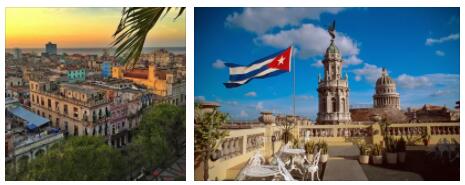Havana, Cuba Economy

According to Educationvv, the economic development of Havana was due, to a large extent, to its geographical location, which made it one of the main commercial hubs of the New World. From the beginning, the city found a source of enrichment in the sugar industry and the slave trade, and later when Cuba achieved its independence, it became a famous vacation destination.
Despite the efforts that the revolutionary government has made to bring industrial production to all corners of the island, Havana continues to be the center of a large part of the national industrial production. The traditional sugar industry, which for three centuries sustained the island economy, is distributed in other locations. But it is in Havana where many of the facilities of the light industry, packaging of meat products and chemical and pharmaceutical industries are concentrated in addition to scientific development.
Other important industries located in Havana are food processing plants, shipyards, vehicle assembly plants, producers of alcoholic beverages (especially rum), textile industries and tobacco products, especially the famous Habanos, a product internationally renowned.
Although the ports of the Cienfuegos and Matanzas province have developed under the revolutionary government, Havana continues to be the main port of Cuba: 50% of imports and exports pass through the city. This port also supports a considerable fishing industry.
Following the collapse of the Soviet Union in 1991 and the intensification of the US blockade against Cuba, Havana and the rest of the country experienced their worst economic crisis since the triumph of the revolution in 1959. The strategy to face this crisis and protect the population was officially called the Special Period in Time of Peace. This city, with a population of about 2.5 million residents (about a fifth of the total population of the country), is the largest city in the Caribbean.
After the fall of the Soviet Union, Cuba once again revived the tourism industry, which is currently the main economic source for Havana and all of Cuba. In addition, in the 1980s, a scientific center was built in the west of the city with institutions from the biotechnology sector, which with high added value export products such as drugs, equipment and vaccines, which compete with counterparts from more developed countries. In this sector.
Sightseeing
Before the triumph of the revolution in 1959 – and especially between 1915 and 1930 – tourism was one of the main sources of Cuban currency (second only to sugar and tobacco). Havana, where a libertine attitude prevailed in everything related to pleasure, was the most popular destination in the Caribbean, especially for Americans, who sought to evade the restrictions imposed by Prohibition at the time.
After experiencing a drastic decrease in the flow of tourism to the island (caused mainly by the Great Depression, the end of Prohibition in the United States and the Second World War), Havana once again began to receive visitors in numbers. significant towards the 1950s, when US organized crime took over much of the country’s leisure and tourism industries. It was the time when the Cuban foreign minister used to boast that Havana spent as much money on parties as any major city in the world. It happens that the island at that time was the safest link in the chain of drug trafficking controlled by the mafia, whose final destination was the United States.
Moreover, the well-justified reputation of being a destination of sensuality and dolce vita had earned it the nickname of “the Latin Las Vegas.” Just to mention a few examples, Meyer Lansky built the Riviera, Santo Traficante came to control shares of Sevilla, and a casino was opened at the Plaza Hotel in this period.
It was the association of American tourism with the world of gambling and prostitution that made this sector seen since 1959 as a social evil that had to be completely eliminated.
Many bars and gambling houses were closed after the triumph of the revolution, and a new government institution, the National Institute of the Tourism Industry, took control of many venues (previously accessible only to the wealthy) and made them available to the public. population. With the deterioration of relations between Cuba and the United States and the imposition of a commercial blockade against the island in 1961, tourism experienced a drastic fall and did not regain a volume remotely similar to that existing before the revolution until 1989.
As a result of the collapse of the Soviet Union and its Eastern European allies in 1989 and in the early 1990s, Cuba was plunged into a severe economic crisis and found itself in dire need of foreign exchange. Part of the solution was to turn to tourism, and the Cuban government invested significant sums in the sector to attract visitors to the country.
As a consequence of these large investments, by 1995 this industry had become one of the main sources of income for Cuba. Havana has traditions, museums and institutions that are true bastions for humanity.
Currently, Havana receives more than 1 million tourists a year, being the main destination for international tourism in Cuba. Its main attraction continues to be its historic center, declared a World Heritage Site by UNESCO since 1982, considered one of the best-preserved architectural ensembles in all of Latin America.